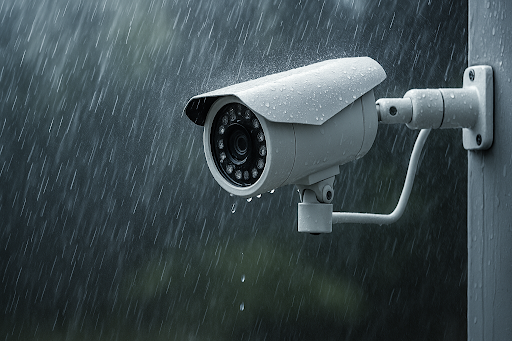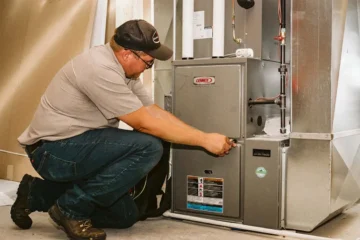The cameras used in the open are at their best in the most unfavorable conditions, downpouring horizontal rain, frigid nights, wind blowing dust, and burning sun in the summer. And should you have a camera outdoors and want it to provide clear, dependable evidence throughout the year, then a bit of planning now will help you avoid blurred images, inaccurate alarms, and flat batteries in the future. Being weather-proof or weatherproofing is how outdoor security cameras work during all seasons, and this guide will tell you all about it in a way that a homeowner, student, or first-time installer can read and do it with minimal equipment.
Why is Weather-Proofing Important to Outdoor Security Cameras?
These are also the things that smarten a camera, tight electronics, sensitive lenses, and small microphones that also make it vulnerable. Wetness can encompass optics fog in addition to connectors that are corroded connectors. Thermal throttling and premature battery fade occur because of heat. Lithium chemistry is slowed at low temperatures, and run time is reduced. Wind and dust produce everlasting movement and dirt that leads to false alerts. The weather-proofing mission is straightforward: the elements stay out, data power stays steady, and the image is usable in real life.
Breaking Down Weather Ratings: IP, IK, and NEMA Deciphered
Outdoor security cameras typically include an IP rating, which is the abbreviation of Ingress Protection. The initial figure indicates resistance to dust, and the second one is water resistance. The marking IP65 denotes protection against jets of water and dust. IP66 represents high-power water jets, and IP67 confers temporary immersion protection. The sweet spot is IP66 or IP67 on most exposed eaves and walls since they deal with wind-driven rain and the disruptive pressure-wash splash.
The availability of impact resistance is reflected in an IK rating. IK08 is used against casual blows; IK above is against an intention to hit the object or hail. When your camera is placed low on a porch or even close to a driveway basketball hoop, impact protection can assist in protecting the lens.
Some housings in North America list NEMA types. NEMA 3, 3R covers weather-proof, NEMA 4 and 4X to the degree of hose-down and corrosion resistance. “4X” corrosion protection is helpful when you are adjacent to the sea or apply de-icing salts.
How to prepare for Seasonal Challenges
Summer Heat: Control of Sun, Glare, And Thermal Stress
Houses and glass are baked by direct sunlight. UV light may cause the plastics to yellow over time, and it may even dry gaskets. Install outdoor security cameras under the eaves or soffits on the north or east, as far as possible. A couple of inches of shade can drop the internal temperatures significantly and decrease the flare in the lens. Morning sun can be blocked with a small hood or by using a new turret or bullet camera that has a very long shroud.
Batteries are also stretched to the limit by heat. Security cameras designed to operate on batteries are convenient, yet they work the most in summer. Reduce cooldown on recording, reduce the length of the clips, and curtail 24/7 upload during heat waves. In ample-volume sites with numerous occurrences–such as a front gate–wired power through the use of PoE (Power over Ethernet) prevents battery drain and ensures consistent performance.
Winter Cold: Battery Life, Ice, And CondenШ§ Сеlimination
Cold decreases capacity and may decelerate or halt charging until cells have warmed. In case you use a rechargeable one, please place it in an area where winter sunlight might touch the panel or the body. Other cameras provide alternative resources by depicting a remotely stationed battery pack in a steadier temperature location. In the case of PoE cameras, cold can be mainly a concern on moving components like mechanical IR cut filters; in a scenario where you get frequent freezes, consider models with a rating down to at least -20C.
The enemy in the winter is condensation. The warm inside air getting indoors through a cable hole mingles with the cold metal and creates the droplet inside the housing. Use exterior-grade silicone to seal any penetrations and make a drip loop in your cable so that water drains away. A small packet of desiccant sits in a service junction box, dries up any remaining moisture and assists in avoiding hazy images on frosty mornings.
Rain, Snow, And Salt: How to Keep the Water Out /How to Keep The Image Clear
Rain driven by wind gets into seams and threads. Always take the rubber grommets and cable glands provided. And tight enough to hold by hand, quarter-turn round with a wrench–snug, not dead. To avoid streaking of snowflakes and false motion, point the camera to capture just slightly downwards in case of snow areas. Droplets can be made to slide off more quickly with a hydrophobic lens coating or the temporary application of a camera-safe water-repellent spray to the glass. On the coast, periodically wash housings using freshwater to prevent a salt film which etches coatings and clouds night vision.
It is Dust, Pollen, And Insects: Winning The Night Vision Battle
Bugs are also attracted to infrared LEDs, and spiders like to tie webs on the warm bezel. That leaves ethereal halos and a sense of continuous movement warning after dusk. A light spraying of peppermint oil solution on the place of mounting–not the lens–will discourage webs. Routine cleaning of the area and a small, permanently on, white illumination source next to the camera will deflect insects out of the IR field and enhance color night shots in camera models with poor light-gathering sensors.
Weather-resistant Power And Connectivity
PoE vs Wi-Fi Outdoor Security Cameras
PoE transports both power and data on a single shielded Ethernet cable. It is steadfast during met-ups, not affected by jamming during Wi-Fi, and can cover a further distance to perfect viewing. In case you have the possibility of pulling a cable, PoE would be the most viable and best when it comes to multi-camera scenarios and NVR. Wi-Fi is well adapted to rentals and fast installations, though it needs careful positioning. Signals at 5 GHz are absorbed in exterior walls and by low-E glass; 2.4 GHz has a longer range and competes with other devices. A node that is rated for outdoor use under the eaves or a point of access powered by PoE along the camera route keeps latency down and clips fill.
Surge Protection, Grounding And Cable Care
Even lightning need not directly strike your house and fry up electronics, since nearby activity will cause surges down the conductors. Make sure you are using surge-protected PoE switches and put an Ethernet surge arrestor wherever the cable goes outside the building. With long exterior runs, use UV-resistant conduit, and instead of sharp metal edges. It should always be made in the form of a drip loop before the entry point to ensure that water does not wick in.
Solar And Battery Planning
Battery outdoor security cameras with solar panels are effective as long as you set your panel angle to your latitude and consider shade between 10 a.m. and 2 p.m. Dust dulls the panels; a simple wipe once a month makes a bigger difference than you might think. Even cold and constant events that cause a battery depleting action can eventually exhaust batteries before small panel tops can fully replenish the power of the battery, so set detection areas and sensitivity to busier seasons.
High Image Quality in High-Contrast Situations
Glare control and Wide Dynamic Range
It is a combination of shadow and direct sun in the same frame, using porches and driveways. The true WDR (wide dynamic range) cameras combine multiple exposures in order to maintain the faces bright and not to blow out the sky. Position the camera in such a way that the sun does not shine on the glass during the peak hours. When you are stuck facing the wrong way, a slightly lower mount on an eave will minimize flare and rain strikes.
Low-Light And Night Vision Options
IR night vision is monochrome; more recent “color at night” sensors are designed with larger pixels and wide apertures to preserve color in the low-light-level conditions found in city streets. In the case of identification and the need to see more faces, turn on a small motion-activated white light closer to the camera; this increases photons, clarifies faces, clearer slow shutter speed, reducing motion-blur. Clean the lens using a soft microfiber cloth monthly and never use household cleaners that cause residue.
Concentration, Field Of View, Elevation Of Mounting.
The broader view is not always preferable. An ultra-wide lens captures the entire yard, where faces will be compressed. To be identified, the best choice will be a walk at chest-level, at about 2.1 to 2.7 meters above the ground and inclined towards the direction of the path that leads to the traffic and not the street. In case you require an overview and identification, you can use two outdoor security cameras, one wide to see the context, and one tighter on the choke point.
Sensible Technology Which Would Be of Use Outside
When adjusted to work outdoors, video analytics will limit false alarming. Person detection and vehicle detection are better than generic motion. No waving branches and busy streets are included in the zone of activity. Package detection to aid porch and loitering alerts close to a gate can be of value in commerce. Spotlights and sirens are installed inside so as to keep casual inquisitors at bay, and spotlights should be pointed away windows of the neighbors, and audio cues should be short and to the point.
Privacy tools count. Covers wearing windows and intimate sections using privacy zones. Disable microphones or use schedules to permit local restrictions on audio recording, particularly where local rules forbid audio recording. Numerous ecosystems connect with voice assistants; make sure that remote observations have to be authenticated and distinct, lengthy passwords should be used per application and NVR.
Storages, Bandwidth, and Redundancy
Cloud storage is easy and safe as long as its suppliers are known companies; however, it relies on uplink bandwidth and subscriptions. Storage using microSD or a network video recorder stores footage on-premises and minimises ongoing expenditure. In serious cameras, do both: log to local as well as upload motion to the cloud. Encode at bitrates supported by your network; consistent 2 to 4 Mbps per camera is a good compromise between quality and stability of 1080p to 2K video. Should you select 4K, increase bitrates and look into H.265 to save on bandwidth, though older equipment can decode H.264 more easily.
Must it be a dome, or a bullet, or a turret: Which housing Weather?
Domes are discrete, though rain and dust may coat the bubble, and the double reflection may be seen at night when the IR is inside. Bullets shed water cleaner and shine IR off the lens behind a clear sheet of glass, but they are more noticeable. Turrets feature a flat protective window, coupled with a small shape, and high performance at night. A turret or bullet provides the most weather-resistant and maintenance-minimal protection to most homes.
Installation Best Practices that Pay off All Year
Begin with a dry test. Turn the camera on, watch the live call on your phone and hold it at the envisioned position. Aim your shot so you partially fill in the approach path, but do not hit the sunny sky or adjacent windows. Apply stainless steel washer head screws and exterior-grade anchors. Place your sealants over all the holes except the weep hole at the bottom of the camera itself. This hole is to allow moisture to escape. Install some connections in a wet location junction box and strain relief so that pulling on the cable does not cause the camera to twist.
Label cameras according to location, not model. The term “Front-Gate-East” is more helpful compared to the term ” Cam-02.” Mark cables on each end. Remind yourself to clean lenses and panels, monitor battery level, storage health, and scan alerts monthly, to see whether your zones require adjustment to precipitation changes as trees leaf or snow freezes into piles that block your views.
Budgeting With No Regrets
The most costly equipment is not necessarily required to procure reliable results. Invest in power stability, optical quality and weather rating. When facing the dilemma of a high-resolution sensor versus flaky Wi-Fi or a 1080P PoE camera that is unbreakable, go for reliable. Iterate a secondary perspective when necessary to get details. With battery models, plan to purchase an extra battery so you can interchange quickly in winter. In the case of PoE, select a switch that has a slight margin of wattage to make sure that in the future, some new cameras and IR illuminators do not eventually are going to blow the limits.
Wisdom in the Real World of Troubleshooting
When you have dirty water or some web close to the IR LED, you will get a foggy halo at night. Clean and inspect a foam gasket located between the lens and the glass, making sure it is loose. When the summer heat results in random reboots, decrease the frame rate and bit rate a little or shade. When winter kills battery run time, cull motion zones on the walkway and reduce clip length. On windy days, when motion alerts fire all night, insert a minimum object size and person detection as opposed to generic motion. Minor adjustments can render a setup that will be heard as a frustrating setup, a fit-and-forget setup.
Conclusion
Security cameras that are used outdoors only work to secure your home when they are online, have clear views and provide usable footage when the conditions are really bad. Pick a housing with appropriate IP ratings and a water-shedding and grime-resistant form factor. Use stable power (ideally PoE) when you have a choice. Install the cameras in shade, provide a reasonable bitrate, and smart detection to minimize wind and insect alerts. Keep lenses clean, keep seals intact, and temper solar panels and batteries through the seasons. By putting these weather-proofing best practices in place, not only can you be assured of summer-heat, winter-frost, and everything in between, but high-quality evidence will be provided by your outdoor security cameras, doing what you installed them to do, with little to no fuss.
FAQs
Does it mean that an indoor camera can be placed outside, provided I put it under an eave?
An eave protects against the sun but not actual wind-tight protection against wind-driven rain, dust, and insects, and indoor plastics break down in UV. There is a safer long-term reliability choice of a proper outdoor security camera with an IP66 or IP67 rating.
What is the coldest environment in which battery-powered cameras operate?
Lithium batteries decay rapidly when cold well below freezing; most models disallow charging till they warm above zero. Planning unplugged/wired power, or a removable battery that you can warm inside and swap as necessary, is also a good idea should you experience extended cold temperatures.
Should I have 4K outdoors?
Small details are easier using resolution, but the quality of the lens, its location, and the type of lighting are more significant in helping identification. An entry-level 1080p or 2K camera with excellent WDR in combination with a well-lit approach path will frequently outcompete a 4K camera that has been installed incorrectly in severe conditions.
Which categories of recognition are mounted at the best height?
A height of about 2.1 to 2.7 meters directed at the approach path is a tradeoff that provides coverage at the expense of face visibility. Set too high above and you find hats and shoulders in the view; set too low and you open to fruit spoiling and headlight glare.
Will a solar panel charge my camera all year round?
Solar is your gadget when the solar panel is exposed to the middle of the day and when your volume of movement is medium. You might feel the need to fade down the recording frequency in winter or crowded scenes, or sometimes even recharge with a charger.
Why does my camera lens get foggy following a storm?
It was caused by moist air entering a cable hole or gasket and condensing as the temperatures varied. Penetrate the reseals, put in a drip loop and dry the housing thoroughly. Recurrence can be prevented by a small desiccant pack located in the junction box.
Do dome cameras work outdoors in the rain?
Dome housings are weather-rated, although droplets and dust on the bubble can blur an image and cause glare at night. A turret or bullet usually remains cleaner with no cleaning as long as there is constant exposure to rain.
Is storing in the cloud more secure than a recording that is local?
The security of cloud clips is off-site, which is useful in case of theft of a device. Local storage offers better storage without any repetitive charges. The best redundancy is provided by a hybrid scheme in which events are recorded locally and mirrored to the cloud when it comes to motion.



